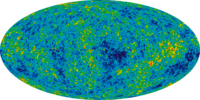
Photo from wikipedia
We investigate the prospects for the direct detection of dark matter (DM) particles, incident on the upper atmosphere. A recent work relating the burst-like temperature excursions in the stratosphere at… Click to show full abstract
We investigate the prospects for the direct detection of dark matter (DM) particles, incident on the upper atmosphere. A recent work relating the burst-like temperature excursions in the stratosphere at heights of ≈38–47 km with low speed incident invisible streaming matter is the motivation behind this proposal. As an example, dark photons could match the reasoning presented in that work provided they constitute part of the local DM density. Dark photons emerge as a U(1) symmetry within extensions of the standard model. Dark photons mix with real photons with the same total energy without the need for an external field, as would be required, for instance, for axions. Furthermore, the ionospheric plasma column above the stratosphere can resonantly enhance the dark photon-to-photon conversion. Noticeably, the stratosphere is easily accessible with balloon flights. Balloon missions with up to a few tons of payload can be readily assembled to operate for months at such atmospheric heights. This proposal is not limited to streaming dark photons, as other DM constituents could be involved in the observed seasonal heating of the upper stratosphere. Therefore, we advocate a combination of different types of measurements within a multi-purpose parallel detector system, in order to increase the direct detection potential for invisible streaming constituents that affect, annually and around January, the upper stratosphere.
Journal Title: Symmetry
Year Published: 2023
Link to full text (if available)
Share on Social Media: Sign Up to like & get
recommendations!